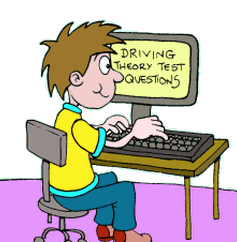Understanding illuminated signals on motorways
The location of the signs and signals that you see on motorway itself tells you some information: who it applies to.
Signs at the edge of the road will apply to all drivers, whilst those that appear above a specific lane for instance from an overhead gantry will apply only to drivers in that particular lane.
Ordinarily these signals are switched off in normal road conditions and just come on when there is some sort of problem affecting normal driving conditions: this could be an accident but in many cases it is due to volume of traffic or perhaps roadwords that are being conducted somewhere along the motorway.
There are amber lights on these signs - two at the top and two at the bottom, and these flash in sequence to help provide a visual clue to you that the sign is on and providing information that you need to read, understand, and react to accordingly adjusting your driving as necessary to conform to the message on the sign. If you see flashing red signals, this means you must stop unless you are able to join another lane.
All of the signs for motorway driving are listed in the highway code and you should take the time to read through them carefully and learn and understand what they all mean. Whilst some of them are obvious - for instance if it says 'Fog' or 'End', not all of them are so obvious and if you can get confused about what the different indicators with regard to which lane you should be in mean, then it is worth learning them.
Some of these signs may crop up in your driving theory test. You can use our sign learning tool for help learning them. Also be sure to sign in and go through all the theory test questions in advance so that you know inside out what the signs mean that might crop up in your driving theory test.
Related Articles...
Before Learning to Drive
The minimum age at which you are allowed to learn to drive a car on public roads is 17. As you probably know, you are not allowed to drive legally on your own until you pass your test. This means...
Your legal obligations as a driver
There are some basics that everyone knows when it comes to being able to behind the wheel of a vehicle. These are of course meeting the legal eyesight requirements, being older than the minimum age...
Your driving licence: getting it back
As the New Drivers Act article outlines, if you get six penalty points or more in the first two years of having a licence, then it is revoked and you have to retake both tests: the theory and the...
The different types of tyre and maintenance
You might tire of talking about tyres, but these are extremely important elements of your car, being the only part that touches the road.
And they need to be in good working order to do their...
What causes accidents: tailgating
Driving too close to a vehicle is dangerous for the very simple reason that you have too little time to react should something unexpected happen. And when you consider how many road journeys there...
Professional driving instructors
When you learn to drive, you have the choice who teaches you. The majority of people decide to learn through a professional driving instructor and often through a major school of...
What is driving test theory?
Theory is something we understand when it comes to maths or science. A theory is a prediction as to why something that has usually been observed to happen does happen, and scientists use theories...
Tips on driving with a heavy load
When you have passed your test and been driving for a while, you might find yourself driving with a heavy load.
For instance if you are going on holiday then you might have lots of stuff that...
What to do in an accident situation
If you do have an accident, then you must stop. Whilst you may read about people driving away from the scene of an accident, you should always stop and face up to any responsibilities involving...
Show me tell me test
If you've not heard of the "show me tell me" test, then this is something
that happens at the start of the driving practical test as opposed to on the
theory test. They ask one of each of the two...
Back to home page of driving theory test questions

